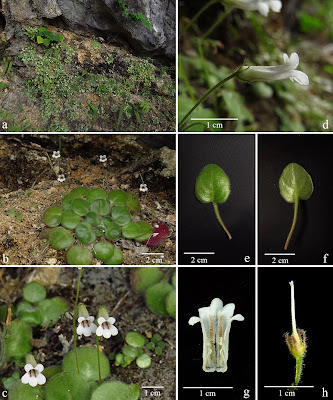Abstract
Background: The Gesneriaceae genus Chiritopsis, confined almost exclusively to cave or cave-like microhabitats of limestone karsts of southern China, was described to distinguish it from Chirita by much smaller flowers and generally miniature plant sizes in the former genus. However, molecular phylogenetic analyses showed that Chiritopsis is polyphyletic and its species delimitation has been problematic. To understand how many times Chiritopsis-like species have evolved from within the recircumscribed Primulina and to further clarify their species identification, we sampled all but two recently described species of Chiritopsis-like Primulina and reconstructed their phylogenetic relationship based on DNA sequences of nuclear ITS and chloroplast trnL-F and trnH-psbA.
Results: With 182 accessions of 165 taxa of Primulina sampled, our analyses placed the 40 accessions of 25 taxa of Chiritopsis-like Primulina in 17 unrelated positions, indicating at least 17 independent origins of the traits associated with caves or cave-like microhabitats. Of the 17 clades containing Chiritopsis-like Primulina, Clade 1 is composed of P. bipinnatifida, P. cangwuensis, P. jianghuaensis, P. lingchuanensis, and P. zhoui, as well as additional samples that show variable and overlapping morphology in leaf shapes. Clade 10 includes P. cordifolia, P. huangii, and P. repanda, while Primulina repanda var. guilinensis is not placed within Clade 10. Primulina glandulosa var. yangshuoensis is not placed in the same clade of P. glandulosa.
Conclusions: Based on our data, P. cangwuensis, P. jianghuaensis, and P. lingchuanensis are proposed to synonymize under P. bipinnatifida, with P. zhoui treated as a variety of P. bipinnatifida. Primulina repanda var. guilinensis is transferred as P. subulata var. guilinensis comb. nov. and Primulina pseudoglandulosa nom. nov. is proposed for P. glandulosa var. yangshuoensis. One new species is named P. chingipengii to honor the late Dr. Ching-I Peng (1950–2018).
Keywords: Convergent evolution, Flora of China, Limestone cave flora, Primulina chingipengii, Primulina subulata var. guilinensis, Primulina pseudoglandulosa, Sino-Vietnamese limestone karst (SVLK), Taxonomy
Primulina chingipengii W.B.Xu & K.F.Chung, sp. nov.
Diagnosis: Primulina chingipengii is similar to P. cordifolia (Fig. 2h–k) in corolla shape, differing by the leaf blade carnose, broadly ovate, cordate to suborbicular, 2–3 × 1.2–2 cm, densely pubescent on both surfaces, base broadly cuneate, round to cordate in the former species.
Etymology: The specific epithet honors Dr. Ching-I Peng (1950–2018), the late Research Fellow of Biodiversity Research Center, Academia Sinica, for his tremendous contribution to our knowledge of the East Asian flora and systematics of Asteraceae, Ludwigia, Begonia, and Sino-Vietnamese karst flora (Chung 2018).
Notes: Primulina chingipengii is similar to P. cordifolia in corolla shape, but it is easily distinguished from the latter by the leaf blades. Phenologically, P. chingipengii and P. cordifolia are also different. Our phylogenetic analyses revealed that P. chingipengii is placed in a strongly supported clade also including P. albicalyx B.Pan & LiH.Yang, P. carinata Y.G.Wei, F.Wen & H.Z.Lü, P. fengshanensis F.Wen & YueWang, and P. pseudoeburnea (D.Fang & W.T.Wang) Mich.Möller & A.Weber (Fig. 4b); however, only P. chingipengii possesses Chiritopsis-like corolla in this clade.
Wei-Bin Xu, Hsuan Chang, Jie Huang and Kuo-Fang Chung. 2019. Molecular Systematics of Chiritopsis-like Primulina (Gesneriaceae): One New Species, One New Name, Two New Combinations, and New Synonyms. Botanical Studies. 60, 18. DOI: 10.1186/s40529-019-0266-x




